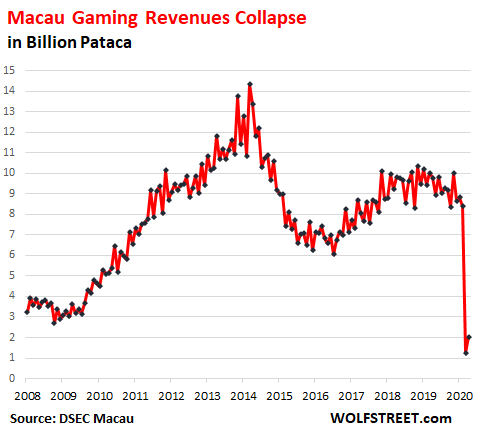Macau Casino Revenue Data
- This statistic shows the gross revenue from gaming and gambling in Macao from 2009 to 2019. Gambling in Macao's casinos generated almost 36.7 billion U.S. Dollars in 2019.
- Gambling tourism is Macau's biggest source of revenue, making up about 50% of the economy. Visitors are made up largely of Chinese nationals from mainland China and Hong Kong. With the entry of large foreign casinos from Las Vegas and Australia, Macau overtook the Las Vegas Strip in gambling revenues in 2007.

Macau Gaming Revenue Data
Macau’s declines in gaming revenue narrowed in October, after plunging at least 90% for six straight months, indicating that China’s relaxation of travel and visa curbs is starting to attract visitors from the mainland.
Gross gaming revenue fell 72.5% to 7.27 billion patacas in October from a year earlier, according to data from the Gaming Inspection and Coordination Bureau.
This was better than the median analyst estimate of a 74% drop.
The figure shows a 228.8% increase in the gross gaming revenue when compared month-on-month.
Revenue in the first 10 months of 2020 has fallen 81.4% to 45.9 billion patacas, according to official data.
The city’s recovery from Covid-19 curbs has been slow after China gradually lifted travel restrictions. Mainland Chinese visitor arrivals during Golden Week in early October were down 84% from a year earlier. However, gamblers are starting to return in volume as a visa backlog clears.
Previously, brokerage Sanford C. Bernstein Ltd estimated that the city’s casino average daily gross gaming revenue for the first eleven days of last month was up 221% compared to the month prior.
Analysts Vitaly Umansky, Tianjiao Yu and Kelsey Zhu estimated that the month-to-date average daily rate was 236 million, which was a 221% rise from the 74 million patacas daily average in September.
Although October’s figure represents a 72% decrease when compared year-on-year, the data already represents an improvement compared to the previous months prior to the reinstatement of Individual Travel Scheme and group visas.
During the National Holiday, the SAR received a total of 156,000 tourist arrivals, a plunge of 86% compared to last year’s Golden Week. The daily average visitor arrivals during the eight-day holiday, which coincided with the Mid-Autumn Festival, stood at 19,538, according to data released by the Macao Government Tourism Office.
During the Golden Week, the central government endorsed travel to national destinations and discouraged its citizens from traveling abroad. However, despite the endorsements, the city’s tourist arrivals still did not meet the expectations of local businesses, including gaming operators.
Still, the number of visitors were said to have increased towards the end of the month, .
Official data shows that mainland visitors accounted for 93% of the total number of visitor arrivals to Macau during the city’s supposedly busiest periods.
“Toward the end of October, the number of visitors increased, but it’s still far away from our normal level,” said Joe Liu, director of the city’s largest e-payment company Macau Pass S.A., which is accepted in more than 18,000 locations including restaurants and retail outlets. But he said the visitors returning first are the high-spending customers who do not hold back.
“They shop and eat crazily,” Liu told Bloomberg.
Analysts say the key to a continued recovery will be a streamlining the visa-issuance process and virus-testing requirements, which currently hinder mainland tourists from visiting Macau.
Meanwhile, in terms of market performance, the Bloomberg Intelligence index of Macau casino operators dropped 5.6% in October amid the slow pace of recovery. MDT/Bloomberg


Macau Casino Revenue Data Services

Macau Casino Revenue Data Search
Gross gaming revenue in the world’s biggest gambling hub dropped 13.7 per cent to 22.84 billion patacas (US$2.85 billion) from a year earlier, the steepest since March 2016, according to data.